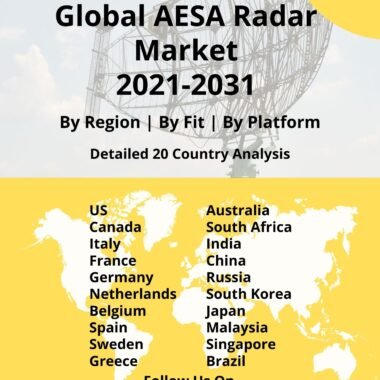Description
Tactical Communication Market
Frequently Asked Questions of Tactical Communication Market
One of the most difficult tasks that military commanders face is communication. The sharing of clear and precise information has always been critical to any successful military operation, and this is especially true in modern times. All facets of combat were rapidly mechanized in the early twentieth century. The use of internal combustion engines in place of horses, along with more effective armament, resulted in significant changes on the battlefield. Soldiers would no longer battle shoulder to shoulder, and commanders would no longer be able to see the action firsthand. With these changes, a good communication system became even more important.
The military relies on a concept known as joint operations in the modern era. This includes all elements of the armed forces, from soldiers on the ground and their support services to close support aircraft and even naval forces. These forces rely not just on clear and secure phone communications, but also on shared data services, resulting in an information network in which all units have access to essential intelligence. The battlefield atmosphere is difficult. Any equipment intended for use on the battlefield must be built to perform in some of the hardest conditions, none more so than infantry systems. Many forces have created their versions of the “future soldier” concept, in which the infantry soldier is outfitted with a variety of communications and data equipment.
Handheld or onboard radios, data linkages and secured networks, military wired buses, and sonobuoy transmitters are all used in the military communications segment. This segment’s instruments must cover a wide range of applications and complicated technologies. They must aim for higher frequencies and greater bandwidth, as well as enable interoperability and coexistence testing (between, for instance, secured waveforms, Wi-Fi, 4G, LTE, and 5G). Furthermore, they must enable evaluations and performance testing for devices with improved transmission ranges and throughput, as well as smaller and more energy-efficient hardware. Operating military radio communications devices under wartime or disaster relief conditions necessitates high-end technological compliance in terms of QoS, dependability, interoperability, environmental robustness, performance, and security.
Major factors driving Tactical Communication Market Growth
Command, Control, Communications, Computers, Information and Intelligence, Surveillance, and Reconnaissance (C4I2SR/C5ISR) systems provide valuable opportunities to the defense and security establishment, acting as an important force multiplier for commanders at all levels in the wake of rapid technological advancements. Communications remain critical in current and future scenarios as militaries compete to strengthen their network-centric warfare capabilities. Continuously improving battlefield communications solutions have progressed through the years to the extremely advanced networks in use today. Given the importance of secure communications in military operations, private and government institutions are always seeking to improve current options. This will be one of the major market trends that will drive market growth.
Trends influencing the Tactical Communication Market Size
Advancements in AI are also one of the major trends influencing the growth of the market. 3D printing will also enable quick and cheaper production of communication interfaces. With growing concerns about cyber security, quantum communications are expected to develop, but phones or laptops equipped with this technology are unlikely to proliferate anytime soon. These devices are still extremely pricey and quite ‘large’ at the moment. One day, it might be possible to construct one that fits on a chip and put one in every computer. Significant technological breakthroughs, however, would be necessary. As the usefulness of the technology becomes more evident, competition among governments to take the next step is heating up. These market trends will influence the growth of the market. Apart from the above-mentioned trends, software-defined radios will also be a trend that will propel the tactical communication market.
Tactical-Communication Market Forecast & Dynamics
Increasing defense spending procurement of newer tactical communication systems. The increase in defense spending will also encourage upgrading existing communication systems across various platforms with newer technologies and equipment. Procurement will also be driven by prevailing geo-political conditions in Europe and the Asia Pacific. The proliferation of artillery systems will be one of the key drivers for the procurement of weapon-locating radars. The market forecast includes a comprehensive market analysis and market size. The market analysis includes regional market size, drivers, restraints, and opportunities. The regional analysis also includes country-wise market size.
Tactical Communication Market Analysis for Recent Developments
The timely delivery of the necessary supplies and men to the appropriate positions on the battlefield has always been the bedrock of any successful mission. With this in mind, the US Army continues to upgrade the way it distributes logistics data on the battlefield, both worldwide and locally. To that end, the Sustainment Transfer System (STS) recently launched three new data transport programs: STS Satellite Communications (SATCOM), STS Line-of-Sight, and STS Wireless-Fidelity (Wi-Fi). According to the present timeline, the Army aims to undertake an STS operational test in the fiscal year 2024 to support the final acquisition and fielding decisions, with fielding expected to commence later that fiscal year under a conditional material release.
Inmarsat L-TAC is a satellite-based communication solution that enables secure voice and data communication in remote and difficult-to-access locations. It employs L-band frequencies, which are less prone to interference and can pass through obstacles such as buildings and foliage. Inmarsat L-TAC is designed to work with existing military radios, making integration into existing communication systems simple. HF radios, VHF radios, and UHF radios are some other tactical communication solutions. HF radios are long-distance radios that can send signals thousands of miles. They are, however, susceptible to atmospheric interference and are not suitable for use in urban environments. VHF radios are short-range radios widely used by law enforcement and emergency services. They are dependable and simple to use, but their range is limited. UHF radios operate at higher frequencies than VHF radios, allowing them to penetrate through obstacles such as buildings and foliage. There are several factors to consider when comparing Inmarsat L-TAC to other tactical communication solutions. The first consideration is range. The Inmarsat L-TAC has a range of up to 5,000 kilometers, making it ideal for use in remote and difficult environments. Although HF radios have a much longer range, they are not suitable for use in urban areas. VHF and UHF radios have a limited range but are dependable and simple to use.







